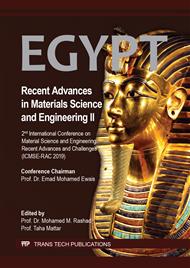p.135
p.141
p.149
p.155
p.163
p.171
p.178
p.186
p.193
Development of Carbidic Austempered Ductile Iron (CADI)
Abstract:
This study aimed at optimizing impact toughness and high wear resistant carbidic austempered ductile iron (CADI) by controlling the morphology, size and quantity of carbides. The effects of dynamic solidification, niobium addition, combined action of them and heat treatment have been investigated. Investigations were performed by means of the image analyzer, scanning electron microscopy (SEM), energy-dispersive spectrometry (EDS) and X-ray diffraction. Impact toughness, hardness and abrasion wear resistance tests were conducted. Fracture surfaces were studied. Results indicated that microstructural control during solidification is the most valuable tool to attain the optimum combination between impact toughness and wear resistance in CADI. Combined action of Nb addition and dynamic solidification improves impact toughness, hardness and wear resistance even more than the action of each individual factor. In the as-cast condition, impact toughness, hardness and abrasion resistance were improved after dynamic solidification compared to statically solidify one by 31.2%, 18.75% and 87.96% respectively. This enhancement was increased to 36.9%, 25.93% and 128. % by adding 1% Nb. Lower tempering temperature of 275°C exhibit best hardness and abrasion resistance better than higher tempering temperature of 375°C.
Info:
Periodical:
Pages:
163-170
Citation:
Online since:
March 2020
Authors:
Price:
Сopyright:
© 2020 Trans Tech Publications Ltd. All Rights Reserved
Share:
Citation:


